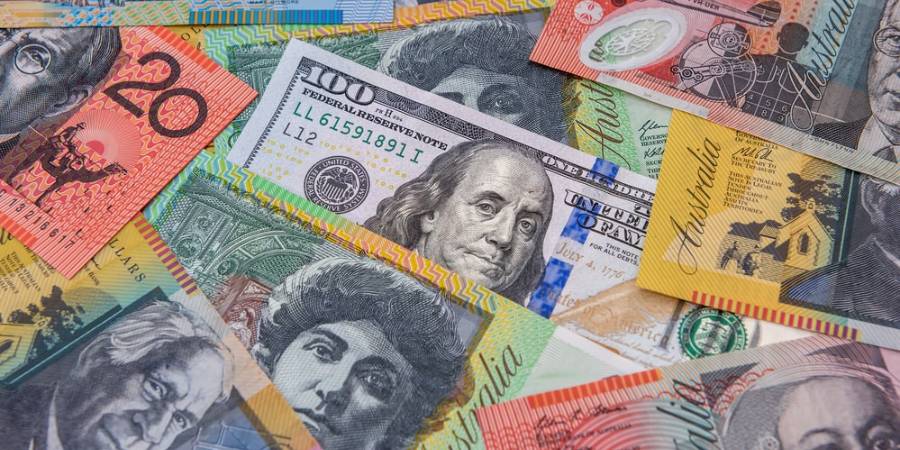Australian Dollar pares gains amid improved US Dollar, awaits US PCE
- Crypto Meltdown. 240,000 Liquidated, $100 Billion Wiped Off Crypto Market Cap.
- When is the US President Trump’s speech at WEF in Davos and how could it affect EUR/USD
- Gold nears $4,700 record as US–EU trade war fears ignite haven rush
- Gold Price Forecast: XAU/USD surges to all-time high above $4,650 amid Greenland tariff threats
- US-Europe Trade War Reignites, Bitcoin’s $90,000 Level at Risk
- Silver Price Forecast: XAG/USD corrects to near $86.50 as Iran stops killing protesters

■ The Australian Dollar remains firmer due to the hawkish sentiment surrounding RBA’s rate trajectory.
■ The Australian Dollar gains in response to the Aussie 10-year yield hitting a 21-week high of 4.59%.
■ The rebound of the US Dollar could be attributed to a shift in market sentiment toward risk-off.
The Australian Dollar (AUD) continues its upward trend for the fifth consecutive session on Friday. The Australian Dollar (AUD) gains momentum against the US Dollar (USD) amid growing support for a hawkish stance from the Reserve Bank of Australia (RBA). This sentiment is strengthened by the reassessment by TD Securities, pushing back the anticipated rate cut by the RBA to February 2025 from November.
The Australian Dollar strengthened further on the back of rising yields in Australian government bonds, with the 10-year yield hitting a 21-week high of 4.59%. This surge is attributed to the recent release of Australia's Consumer Price Index (CPI) data on Wednesday, which surpassed expectations and triggered a hawkish sentiment surrounding the RBA.
The US Dollar Index (DXY), which measures the performance of the US Dollar (USD) against six major currencies, rebounds, potentially influenced by a shift toward risk-off sentiment. However, this gain could be limited due to the downward correction in US Treasury yields, which contributed to the weakening of the Greenback.
Despite mixed preliminary data released from the United States (US) on Thursday, including higher-than-expected Core Personal Consumption Expenditures and lower-than-expected Gross Domestic Product Annualized for the first quarter, the US Dollar remained subdued.
Market attention now turns to the US Personal Consumption Expenditures (PCE) Price Index data for March, scheduled for release on Friday. This data is anticipated to draw significant focus as investors gauge its implications for inflationary pressures and potential impacts on US monetary policy.
Daily Digest Market Movers: Australian Dollar appreciates due to the hawkish RBA
In the first quarter, the US Gross Domestic Product Annualized (Q1) expanded at a slower pace, growing by 1.6% compared to the previous reading of 3.4%. This figure fell short of market expectations, which anticipated a growth rate of 2.5%. The deceleration in GDP growth suggests potential headwinds or slowdowns in various sectors of the economy.
US consumer prices have demonstrated resilience, with the latest data indicating that the Personal Consumption Expenditures (QoQ) Price Index for Q1 increased at a 3.7% annual rate. This surpassed both market expectations of 3.4% and the previous reading of 2.0%. The persistent upward movement in consumer prices may indicate ongoing inflationary pressures, which could influence monetary policy decisions by the Federal Reserve.
The US Initial Jobless Claims for the week ending on April 19 experienced a significant decrease, falling by 5,000 to 207,000. This figure marks the lowest level seen in two months and surpasses both market expectations of 214,000 and the previous reading of 212,000. This unexpected decline in jobless claims indicates a strengthening labor market, suggesting reduced layoffs and potentially increased hiring activity.
According to the CME FedWatch Tool, the likelihood of the Federal Reserve's (Fed) interest rates remaining unchanged in the June meeting has risen to 85.2%, up from Wednesday’s 83.5%.
Luci Ellis, the chief economist at Westpac and former Assistant Governor (Economic) at the Reserve Bank of Australia, notes that inflation slightly exceeded expectations in the March quarter. Westpac anticipates that the Board will keep interest rates unchanged in May and has adjusted their forecasted date for the first rate cut from September to November this year.
In March, the Consumer Price Index (CPI) indicator in Australia rose to 3.5% YoY. While this figure exceeded expectations of 3.4%, it represented the highest level in four months. The uptick was primarily driven by faster increases in housing and transport prices.
Excluding volatile items and travel, the monthly Australian CPI indicator climbed to 4.1% in March, up from a 3.9% gain in February. Despite this rise, inflation continues to remain outside the Reserve Bank of Australia's target range of 2-3%, indicating ongoing challenges in achieving the desired level of price stability.
Technical Analysis: Australian Dollar holds position above 0.6500
The Australian Dollar trades around 0.6520 on Friday. The pair has breached into a symmetrical triangle pattern, with the 14-day Relative Strength Index (RSI) above the 50-level, supporting this bullish outlook.
The AUD/USD pair could target the pullback resistance at the level of 0.6553. A breakthrough above the latter could lead the pair to approach the psychological level of 0.6600 and aim for the triangle's upper boundary near 0.6639.
On the downside, immediate support is expected around the psychological level of 0.6500. A break below this level may lead to further downside momentum, with the next significant support region around 0.6443, following further support at April’s low of 0.6362.
AUD/USD: Daily Chart
Read more
* The content presented above, whether from a third party or not, is considered as general advice only. This article should not be construed as containing investment advice, investment recommendations, an offer of or solicitation for any transactions in financial instruments.





